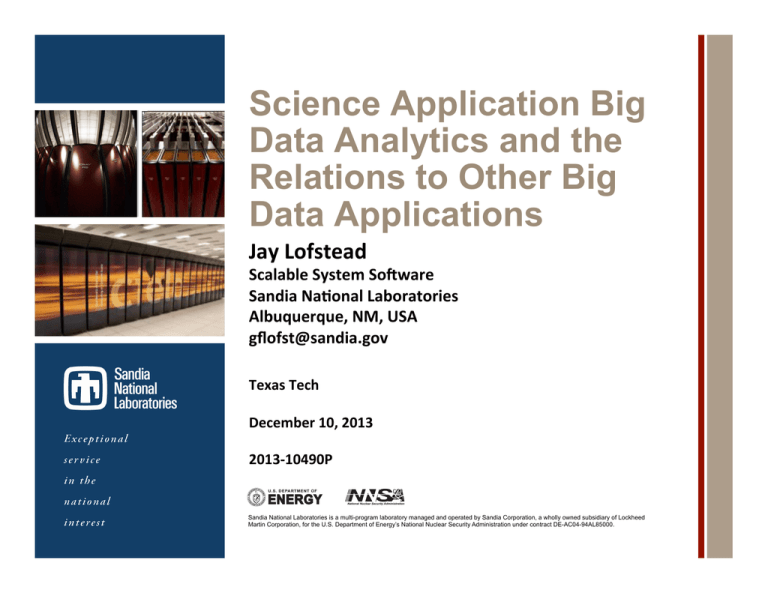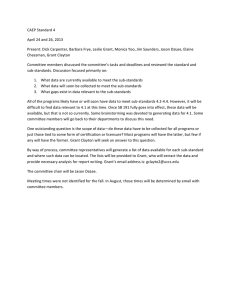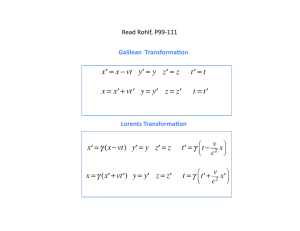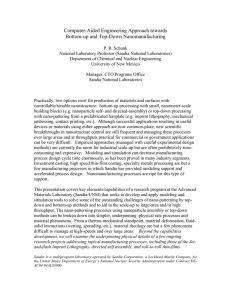Document 11499064
advertisement

Science Application Big Data Analytics and the Relations to Other Big Data Applications Jay Lofstead Scalable System So1ware Sandia Na7onal Laboratories Albuquerque, NM, USA gflofst@sandia.gov Texas Tech December 10, 2013 2013-­‐10490P Sandia National Laboratories is a multi-program laboratory managed and operated by Sandia Corporation, a wholly owned subsidiary of Lockheed Martin Corporation, for the U.S. Department of Energy’s National Nuclear Security Administration under contract DE-AC04-94AL85000. What is “Big Data”? Popular current defini9on revolves around the three Vs: § Velocity § Quick insights § Variety § Web page hits and purchases on an e-­‐commerce site § Volume § Fast moving stream of tweets or Facebook posts § and some9mes others like Value § Does this data stream offer poten9al useful data points if it can be correlated? 2 What is “Big Data”? Typical characteris9cs: § Small data items § Formats may vary depending on source, but each item small (< 1 KB) § Sor9ng and correla9ng data to find paPerns § “Map” to tag items and “Reduce” to sort them into buckets § Timely relevance § “trending” news stories based on what people are saying or tagging § What items to promote to people viewing this item? 3 What is “Big Data”? § What about data sets of 10s of TB of discrete items? § Data warehouses of transac9onal data § What about a single data item of 1 PB or more? § World climate model at 1 km scale including mul9ple layers of atmosphere, land, ocean, and ice sheets § What about years (decades) worth of data? § Long-­‐term health studies § Climate data § Census data 4 Big Data of Old Pre-­‐21st century two extremes: § Data Warehousing – LOTS of small items to correlate § Healthcare § Commerce (offline world) § Computa9onal Science – a small number of BIG data items § Simula9ons § Data analy9cs for experimental or observa9onal data (or both simultaneously) 5 Data Warehousing § Lots of data, but… § Data fed from transac9onal sources to larger storage offline § Avoid impact on transac9onal system § Data “normalized” into expected rela9onal format § Format data into pre-­‐defined fields for a range of queries § Examples § For a par9cular diagnosis, what treatment regimens yield what outcomes at what costs, order by cost, success rate (drive treatment recommenda9ons and reimbursement amounts) § What people buy par9cular products (direct marke9ng expenditures for direct mail campaign for a different product) 6 Computa9onal Science BIG codes that compute heavily for every output. Rela9vely small number of immense data “items” § Climate simula9ons § Land, ocean, land ice, sea ice, and atmosphere models all interact to represent the global climate § Fusion reactors § Model the magne9c containment field and plasma for genera9ng clean energy on demand § Materials § Shock physics for explosions § Oil explora9on § Simula9on of ground + observa9onal data to determine where to drill for best yield at lowest cost 7 Emerging “Big Data” § Science data analysis sharing characteris9cs § Lots of small items § Independent evalua9on § Biology-­‐applica9ons (e.g., genomics searches) § Par9ally “old” science applica9on characteris9cs (large single data set) § Par9ally “new” big data (independent analysis of individual items) 8 Spectrum of Big Data Big data items Smaller number of items Science Simulations Biology-Style Science Small individual items Large numbers of items Current “Big Data” Data Warehousing 9 Science Analy9cs § Visualiza9on § § § § § What are data ranges? What is the rendering space compared to the simula9on space? What angle to view from? How to render each data element? What data elements to render on the same image? 10 Science Analy9cs § Par9cle, fragment, or “energy” tracking § For par9cles that escape magne9c containment, how did they generate the velocity? § When a material explodes, how does it fragment and where do these fragments go and break apart over the simula9on 9me? § Iden9fy an atmospheric energy burst (storm) and where is it predicted to go § Trending for a value over 9me (when does the temperature in a combus9on simula9on reach the igni9on temperature/pressure?) 11 Science Analy9cs like Big Data § What kinds of analysis can be done using big data tools? § § § § Histograms Merge sort of a data set Bounding box data selec9on Data indexing (bucket-­‐based ranges, e.g., FastBit) 12 Workflow Structure § Similar to Map-­‐Reduce, but with constraints 13 When and Where to do Analy9cs? § In-­‐Situ – in same process space as applica9on § Offline – based on data stored on persistent storage 14 When and Where to do Analy9cs? § In-­‐Transit – use resources on IO path to transform or annotate data as it moves 15 Fusion Science Today § Physical experimental equipment: Joint European Torus § About 80% efficient § LOTS of diagnos9c data § § § § Visible and infrared cameras Magne9c field and current measurement X-­‐ray monitors Several others § ITER (next genera9on) § 40 TB data per shot (400 seconds long) every 1600 seconds § Gather data to validate and drive simula9on to build next genera9on (may need to change simula9on approach) 16 Fusion Science Today § How do we capture 40 TB in 400 seconds? § Can we process it in 1600 seconds to make adjustments or determine if maintenance is required? 17 Shock Physics § Explosion modeling for anything from a pipe bomb to a nuclear warhead § Model is a collec9on of atoms at par9cular distances from each other § Simula9on progresses as energy (or igni9on) added to see how material behaves § Ideal situa9on: See how fragments are formed and track their movement through life of simula9on § Problem: IO bandwidth woefully inadequate today 18 Shock Physics § In-­‐Situ problema9c § 30 MB for just CTH, 300 MB CTH + ParaView § CTH scales fine to 100K processes, ParaView, not so much § Offline impossible § I/O 9me would exceed computa9on 9me just to output sufficient data § Does not include reading 9me, analysis 9me, or wri9ng 9me for fragments 19 Shock Physics § In Transit § Decouple scalability issues § Absorb data at network rather than storage speeds § Process data down into fragments and write fragments (MUCH smaller data) § Enables fragment tracking! 20 What is Wrong with In Transit? § In Situ – fast, clear transfer/communica9on of data. § If simula9on fails, analysis fails (or vice versa) § Offline – disk offers persistence and seman9cs for data processing, but slow § Failures just require restar9ng failed component § Must address limita9ons of both to get In Transit acceptable: 1. 2. 3. 4. What is equivalent to a file when doing a network transfer (MxN)? How to control access to data prematurely? How to evolve data reliably? What should the interfaces be? 21 Storage Seman9cs for In Transit § Storage Seman9cs worth replica9ng § “blocking” of data into a data set § Controlled access to a data set § Persistence § Storage Seman9cs worth avoiding § Delays in IO stack preven9ng knowledge of “real” comple9on of IO task 22 Transac9ons § Yes, just like from databases—but much harder § Problems: § We have parallel clients and mul9ple servers (MxN) § Must incorporate black box servers § We have several data items in a single set, all of which are distributed 23 D2T – Doubly Distributed Txns § Revised protocol § Sub transac9ons for each item (variable) § Overall transac9on for overall blocking § Low requirements for servers to par9cipate § Client-­‐side only coordina9on 24 D2T Structure § Mul9ple roles for some processes § 0 is coordinator, sub-­‐coordinator, and subordinate § 3 is sub-­‐coordinator and subordinate S1 S2 S3 § 1, 2, 4, 5 are all just subordinates § S1, S2, S3 are servers 25 Transac9on Performance § Notes: § § § § Always used at least 2 sub-­‐coordinators to slow it down Added a sub-­‐coordinator when subordinate count exceeded 256 64K processes = 256 sub-­‐coordinators with 256 subordinates each Overhead only for complete set of transac9on calls (no op. costs) 26 What About Persistence? § Persistence for data staging is an open problem § What role will new memory types play? 27 Harder Problems § Coupling the physics What are the 9me and space scales for simula9ons and analysis? Is the simula9on wriPen to accept a partner computa9on? What about only in one direc9on? How oxen can data be exchanged? How oxen should data be exchanged? How to handle the interface zones where meshes (or other simula9on data organiza9ons) meet? § How does the physics change in the presence of the new data? § § § § § § 28 Big Data Tools and Science Analy9cs § Science simula9on analy9cs may work with some big data tools (Sci-­‐Hadoop) § Some scale out techniques useful for scale up § process everything possible in parallel isola9on and only coordinate in a 9ghtly integrated, small area § Incorporate resilience as a fundamental feature of any workflow 29 Ques9ons? § gflofst@sandia.gov § www.lofstead.org 30








